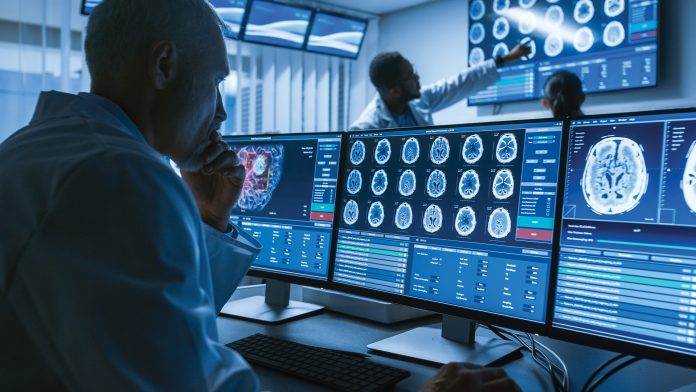Phase Shift’s Scott Chester explains why hiring a healthcare technology designer early in a project could be more beneficial than a line item for the latest healthcare equipment

It’s a curse and advantage of being a technology designer: we know just how beneficial technology can be in the right hands. For our healthcare clients in particular, the right systems and technology can drive them toward workflow efficiencies, improved patient outcomes, and more profitable businesses, but we are often brought in too late in a project to develop a vision or technology program that could make the facility and larger organization truly stand out.
During a typical project cycle, we are often brought into a project at the end of Schematic Design or even early Design Development, which is usually after the major design decisions have been made. The programming budget has already been established with a specific dollar figure for technology after someone on the front end has set aside a budget for some basic technology, unaware of the cost and implications of incorporating the latest healthcare technology into the project.
We have to bear the news that if the initial budget is cast in stone, the client will end up with a beautiful, brand new building with just a network and a basic nurse call system, without the state-of-the art technology, like RTLS solutions, wayfinding, wireless integration for caregivers’ mobile devices, patient entertainment, telemedicine, telesitter and EICU technology in patient rooms. While this may sound like a lot, and in some cases it certainly is, these features are quickly becoming baseline technology for healthcare’s ever-increasing thirst for innovation.
In case you’re unfamiliar with the term, RTLS (Real Time Location System) in a healthcare environment is a system that deploys sensors that can be used for improving and streamlining workflows. Some of the applications include patient, caregiver, and equipment tracking, automating alarm activities, alarms for hand sanitizing, alerts for occupied and unoccupied rooms, and wayfinding for visitors, who can easily navigate a complex network of hospital corridors with an app on their phones.
RTLS can be an amazingly effective tool, and a great way of boosting a facility’s operational efficiency, but when we are brought on to a project late in the game, we begin talking more deeply about the organizational infrastructure necessary to manage the system, use it in effective ways, compile the data, and respond and react to it. In other words, we’re reactive rather than proactive. Sadly, some clients realize they don’t have the human infrastructure or budget to manage it. Of course, we always do whatever we can for our clients and we typically end up planning infrastructure in the building so it can support these technologies in the future, but that can actually be more expensive in the long run over bringing on an experienced technology consultant in the early stages to create a comprehensive vision for a project.
Coordination + Expertise = A Better Healthcare Facility
Tapping the full depth of a tested, experienced consultant is becoming more of a necessity as healthcare technologies become more complex and systems all require full integration. And, of course, security is always top of mind, both physical, on-site security for patients and staff, as well as cyber security for data and personal information.
For physical security, everyone on the design team needs to understand how staff, patients, and visitors flow through various departments and areas of a healthcare facility in order to create a hierarchy of checks or “gates” and access points. This requires significant knowledge regarding the workflows and clinical objectives within various departments, understanding of the technology and equipment itself, and extensive coordination with the end-users and architectural team to make sure the architectural program and the technology systems are working together in a cohesive way.
In terms of cyber security, the trend is moving toward an increasingly connected and integrated technology ecosystem within buildings. When technology systems, medical equipment, and electronic medical records are integrated and connected over the network, any security vulnerability could be disastrous. The earlier the technology consultant can get involved in a project, and identify these potential vulnerabilities, the more likely it is they can be avoided entirely.
Technology for the Patient Experience
If technology is designed and implemented correctly, it can have enormous benefits for healthcare organizations, from staff efficiency to patient satisfaction to the safe archival of very sensitive information. We can build technology solutions directly into the building that allow staff to maximize their time with patients, get the most efficient use of equipment and facilities, and, of course, drive the best possible outcomes.
In one recent assignment, we combined RTLS integration with a nurse call communications system, a wireless mobility solution for caregivers and the patient entertainment TV system. This simple system, once integrated, boosted patient room utilization, decreased care-giver to bedside time and contributed to a more relaxing and enjoyable patient experience—all of which have proven to be essential factors in positive outcomes.
Technology and healthcare have become inextricably linked, but technology designers and consultants can only focus on these crucial elements if we have the time and budget to integrate the pieces in a holistic solution. Coming on board earlier in the process allows us to do what we do best: solve our clients’ challenges rather than having to force a less optimal system to work.
About the Author

Scott Chester, CTS-D, is a principal at Phase Shift Consulting, experts in technology in the built environment. While his experience is diverse, Scott has developed a particular expertise in healthcare, leveraging technology to enhance the patient experience, drive improved outcomes and remove operational inefficiencies. He has worked with such academic-related hospitals as the University of Chicago Medical Center and Ohio State University Medical Center as well as Boston Children’s Hospital and the Children’s Hospital of Philadelphia.
